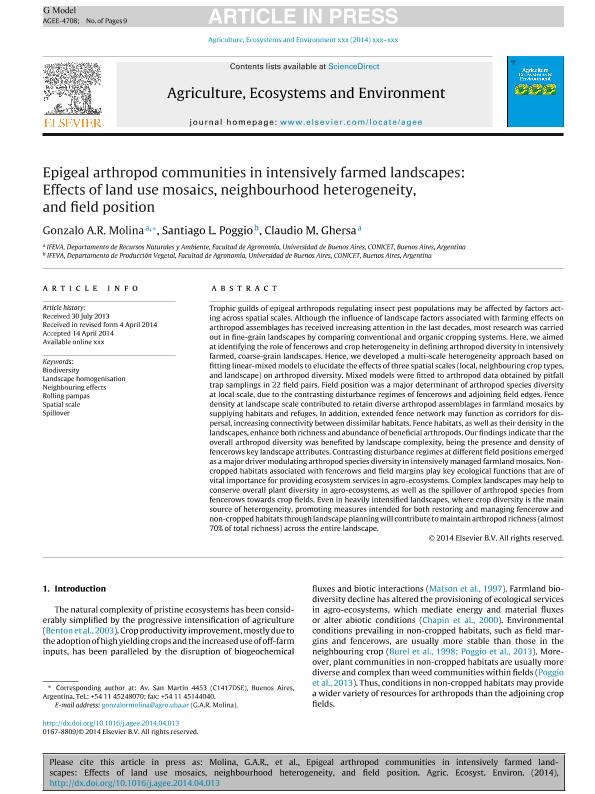Artículo
Epigeal arthropod communities in intensively farmed landscapes: effects of land use mosaics, neighbourhood heterogeneity, and field position
Fecha de publicación:
10/05/2014
Editorial:
Elsevier
Revista:
Agriculture, Ecosystems and Environment
ISSN:
0167-8809
Idioma:
Inglés
Tipo de recurso:
Artículo publicado
Clasificación temática:
Resumen
Trophic guilds of epigeal arthropods regulating insect pest populations may be affected by factors act-ing across spatial scales. Although the influence of landscape factors associated with farming effects onarthropod assemblages has received increasing attention in the last decades, most research was carriedout in fine-grain landscapes by comparing conventional and organic cropping systems. Here, we aimedat identifying the role of fencerows and crop heterogeneity in defining arthropod diversity in intensivelyfarmed, coarse-grain landscapes. Hence, we developed a multi-scale heterogeneity approach based onfitting linear-mixed models to elucidate the effects of three spatial scales (local, neighbouring crop types,and landscape) on arthropod diversity. Mixed models were fitted to arthropod data obtained by pitfalltrap samplings in 22 field pairs. Field position was a major determinant of arthropod species diversityat local scale, due to the contrasting disturbance regimes of fencerows and adjoining field edges. Fencedensity at landscape scale contributed to retain diverse arthropod assemblages in farmland mosaics bysupplying habitats and refuges. In addition, extended fence network may function as corridors for dis-persal, increasing connectivity between dissimilar habitats. Fence habitats, as well as their density in thelandscapes, enhance both richness and abundance of beneficial arthropods. Our findings indicate that theoverall arthropod diversity was benefited by landscape complexity, being the presence and density offencerows key landscape attributes. Contrasting disturbance regimes at different field positions emergedas a major driver modulating arthropod species diversity in intensively managed farmland mosaics. Non-cropped habitats associated with fencerows and field margins play key ecological functions that are ofvital importance for providing ecosystem services in agro-ecosystems. Complex landscapes may help toconserve overall plant diversity in agro-ecosystems, as well as the spillover of arthropod species fromfencerows towards crop fields. Even in heavily intensified landscapes, where crop diversity is the mainsource of heterogeneity, promoting measures intended for both restoring and managing fencerow andnon-cropped habitats through landscape planning will contribute to maintain arthropod richness (almost 70% of total richness) across the entire landscape.
Archivos asociados
Licencia
Identificadores
Colecciones
Articulos(IFEVA)
Articulos de INST.D/INV.FISIOLOGICAS Y ECO.VINCULADAS A L/AGRIC
Articulos de INST.D/INV.FISIOLOGICAS Y ECO.VINCULADAS A L/AGRIC
Articulos(OCA PQUE. CENTENARIO)
Articulos de OFICINA DE COORDINACION ADMINISTRATIVA PQUE. CENTENARIO
Articulos de OFICINA DE COORDINACION ADMINISTRATIVA PQUE. CENTENARIO
Citación
Molina, Gonzalo Alberto Roman; Poggio, Santiago Luis; Ghersa, Claudio Marco; Epigeal arthropod communities in intensively farmed landscapes: effects of land use mosaics, neighbourhood heterogeneity, and field position; Elsevier; Agriculture, Ecosystems and Environment; 192; 10-5-2014; 135–143
Compartir
Altmétricas




